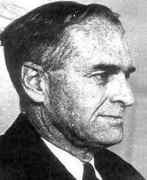Person: Alexander (2), James Waddell

James Alexander was an American mathematician who worked in topology. He is best known for the knot-theory invariant known as the Alexander polynomial.
Mathematical Profile (Excerpt):
- John White Alexander was quite famous in his own right as an artist and painter of murals.
- Alexander studied mathematics and physics at Princeton, where he was a student of Veblen, obtaining a B.S. degree in 1910 and an M.S. degree in 1911.
- During this period abroad, Alexander studied at Paris and Bologna.
- In 1917, after marrying Natalia Levitzkaja on 15 January, later that year Alexander served as a lieutenant in the U.S. Army Ordnance Office at the Aberdeen Proving Ground.
- By the end of the war Alexander had reached the rank of captain.
- Alexander, however, never drew a salary from the Institute for Advanced Study.
- Alexander had virtually become a recluse after he retired in 1951 and the McCarthy era resulted in his disappearance from public life.
- Alexander's work around this time went a long way to put the intuitive ideas of Poincaré on a more rigorous foundation.
- Also before 1920 Alexander had made fundamental contributions to the theory of algebraic surfaces and to the study of Cremona transformations.
- Soon after arriving in Princeton, Alexander generalised the Jordan curve theorem and continued his work, now exclusively on topology, with an important paper on the Jordan-Brouwer separation theorem.
- This latter paper contains the Alexander Duality Theorem and Alexander's lemma on the nnn-sphere.
- In 1924 he introduced the now famous Alexander horned sphere.
- In 1928 he discovered the Alexander polynomial which is much used in knot theory.
- In the same year the American Mathematical Society awarded Alexander the Bôcher Prize for his memoir, Combinatorial analysis situs published in the Transactions of the American Mathematical Society two years earlier.
- The theory which is now called the Alexander-Spanier cohomology theory, was introduced in 1935 by Alexander but was generalised by Spanier in 1948 to the form seen today.
- Also around 1935 Alexander discovered cohomology theory, at essentially the same time as Kolmogorov, and the theory was announced in the 1936 Moscow Conference.
- Among the many honours bestowed on Alexander was his election to the American Academy of Sciences in 1930.
Born 19 September 1888, Sea Bright, New Jersey, USA. Died 23 September 1971, Princeton, New Jersey, USA.
View full biography at MacTutor
Tags relevant for this person:
Origin Usa, Topology
Thank you to the contributors under CC BY-SA 4.0! 

- Github:
-

- non-Github:
- @J-J-O'Connor
- @E-F-Robertson
References
Adapted from other CC BY-SA 4.0 Sources:
- O’Connor, John J; Robertson, Edmund F: MacTutor History of Mathematics Archive
